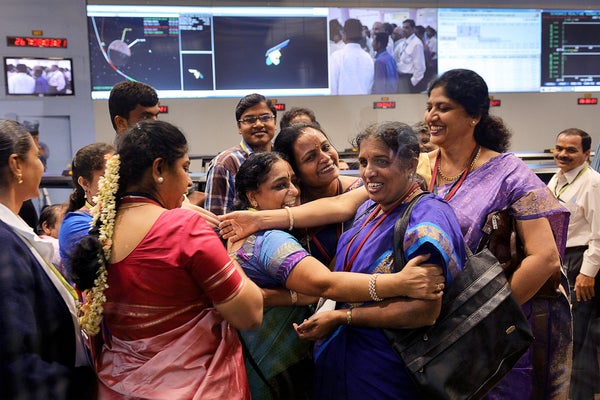When Chandrayaan-3 landed on the south pole of the moon this year, there were many exciting pictures on the news. Among them, the ones that particularly tugged at my heart were those of the women scientists of the Indian Space Research Organization responsible for the mission, wearing saris.
This is not the first time Indian space scientists in saris have made international headlines after a successful launch. But while these latest images are a history-making moment for humanity, for me—a computational biology Ph.D. student from another sari-wearing country, Sri Lanka—they also mark a continued shattering of the stereotypical image of a scientist. These photos remind the world—and science—that greatness comes in all colors, shapes and sizes, not to mention clothing.
Fashion and cultural identity obviously do not determine scientific excellence, but even small elements of traditional dress—a piece of jewelry, a hairstyle or a tattoo—along with saris and other traditional dress can unmistakenly represent a scientist’s cultural or national heritage and build confidence in the workplace. In this way, fashion can promote diversity and understanding in science, and should be welcome.
On supporting science journalism
If you're enjoying this article, consider supporting our award-winning journalism by subscribing. By purchasing a subscription you are helping to ensure the future of impactful stories about the discoveries and ideas shaping our world today.
Numerous studies have found that students—even those from non-Western cultures—view scientists as white, male, and wearing a white lab coat, while holding chemistry glassware such as beakers or flasks. I am a biologist studying the evolutionary history of algae. My work is entirely computer-based. I never need to wear a white lab coat, nor do I need to wear the outdoor gear common to field scientists.
Scientists have already advocated for diversity in appearance and dress through pictures on social media of them working in various settings. And for students’ stereotypical views, mentoring sessions and virtual discussions with scientists have begun to turn the tide. However, these studies and awareness builders give limited attention to the role of cultural fashion in scientists’ identity. While we have studies that look at fashion and psychological outcomes in the workplace, I’m not aware of anything similar specific to scientific research environments.
It is an important question: How do our clothing choices affect our well-being and acceptance in our scientific workplaces?
I recall a graduate student from Myanmar I knew in Sri Lanka, who came to the lab everyday wearing her country’s traditional light yellow thanakha paste made of ground bark, on her face and neck. My fellow graduate students at the University of Florida who are from China, Colombia and India have told me that they like incorporating such cultural fashion into their work wardrobe.
But sometimes, my fellow graduate students tell me they hold back because of concerns about being targeted as foreigners, being perceived as unprofessional and not fitting into mainstream academic culture. Dressing for comfort should not create professional anxiety.
When I wear Western smart casual in the U.S., I am often misidentified as Indian, as is the case for many non-Indian South Asians. However, when I wear the Sri Lankan osaree, some people recognize me correctly as being “from the country of Mrs. Bandaranaike,” the world’s first female prime minister. Bandaranaike proudly wore our national dresson every public occasion. Just as renowned political and cultural world leaders are identified with fashion unique to their countries, identifying international scientists in the same way could add a new level of recognition of diversity in science.
My colleague from Myanmar wore a graceful longyi, her country’s national costume, for her thesis defense. The garment comprises a floor-length wraparound skirt and long-sleeve top. With these details, she demonstrated how important her culture and traditions were to her as a scientist. In an international scientific setting, it not only made her an ambassador of her culture, but also helped her to keep her homeland close while she was far away.
Conferences are another international scientific setting where fashion matters. Nowadays, in addition to striving for a “professional” look, many academic conference attendees go for attire that makes them feel comfortable. Encouraging scientists to wear fashion associated with their cultural identity, if that’s what they are comfortable in, would also be welcome guidance.
This likely resonates with many international scientists working abroad.
Portrayals of scientists from around the world in styles unique to their cultures, working in their local environments, can give a huge boost of encouragement to kids and young scientists from the Global South. It can also help show children in the Global North another view of scientists.
In the “Where I Work” section of Nature Careers, there are scientists in clothing from a range of cultural identities: a Nepalese climatologist in a kurta top and wide-legged pants, a Jamaican ethnopharmacologist in a Ghanian dashiki, a Ugandan veterinarian with hair braids, a Lebanese-American computational chemist in a hijab and a Maori physicist in Indigenous jewelry. These fashions tell stories about scientists’ inspirations as well as their aspirations. These remind us of diversity in science, but also that scientists are doing remarkable work in their own countries, often with limited resources.
The Indian Space Research Organization’s women scientists, who are being hailed as “Saree Trailblazers” on the Internet, remind me that cultural identity should be on full display in science. My mother, who studies agriculture in Sri Lanka, often wears an osaree as part of her campaigning. But here in the U.S., I have often wondered whether my university website picture, in which I am wearing an osaree,appears out of place.
After seeing the pictures of Chandrayaan-3 scientists, I have renewed confidence to embrace my cultural attire and continue to make it a part of my scientific journey. I hope that others will follow.
This is an opinion and analysis article, and the views expressed by the author or authors are not necessarily those of Scientific American.
